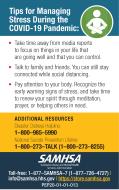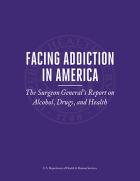This guide reviews ways that telehealth modalities can be used to provide treatment for serious mental illness and substance use disorders among adults, distills the research into recommendations for practice, and provides examples of how these recommendations can be implemented.
Dashboard: Filter Bricks
Main page content


The wallet card provides stress reduction tips and techniques as well as lists sources for additional assistance.

This executive summary of the Surgeon General's Report on Alcohol, Drugs, and Health addresses alcohol, illicit drugs, and prescription drug misuse in the United States. Chapters of the report cover neurobiology, prevention, treatment, recovery, health systems integration, and recommendations for the future.

This Surgeon General's Report on Alcohol, Drugs, and Health addresses the prevalence of alcohol, illicit drugs, and prescription drug misuse in the United States. Chapters of the report cover neurobiology, prevention, treatment, recovery, health systems integration, and recommendations for the future.

For individuals at risk of suicide, primary and behavioral health care settings provide unique opportunities to connect with the health care system and access effective treatment. Suicide Safe is a free mobile app that helps providers integrate suicide prevention strategies into their practice and address suicide risk among their patients. The Suicide Safe app is based on SAMHSA's Suicide Assessment Five-Step Evaluation and Triage (SAFE-T) card.
With Suicide Safe, primary and behavioral health care providers can:
- Learn how to use the SAFE-T approach when working with patients.
- Explore interactive sample case studies and see SAFE-T in action through case scenarios and tips.
- Quickly access and share information, including crisis lines, fact sheets, educational opportunities, and treatment resources.
- Browse conversation starters that provide sample language and tips for talking with patients who may need suicide intervention.
- Locate treatment options, filter by type and distance, and share locations and resources to provide timely referrals for patients.
For more information, email SAMHSA at samhsainfo@samhsa.hhs.gov.

In a disaster, it's essential that behavioral health responders have the resources they need—when and where they need them. The free SAMHSA Disaster App offers first responders immediate access for any type of traumatic event at every phase of response, including pre-deployment preparation, on-the-ground assistance and post-deployment resources.
With the SAMHSA Disaster App, first responders can:
- Access resources including tip sheets; guides for responders, teachers, parents, and caregivers; and a directory of behavioral health service providers in the impacted area.
- Download information on your phone before deployment in case of limited Internet connectivity in the field.
- Review key preparedness materials to help you provide the best support possible.
- Send information to colleagues and survivors via text message, email, or transfer to a computer for printing.
- Find interventions to help survivors of infectious disease epidemics.
Find SAMHSA’s disaster response information as a publication. Download the SAMHSA Disaster Kit.
For more information, email SAMHSA at samhsainfo@samhsa.hhs.gov

This report presents findings from a national cross-site evaluation of the Safe Schools/Healthy Students (SS/HS) initiative. SS/HS supports the collaborative planning and implementing of programs and services to foster safer schools and healthy students.

